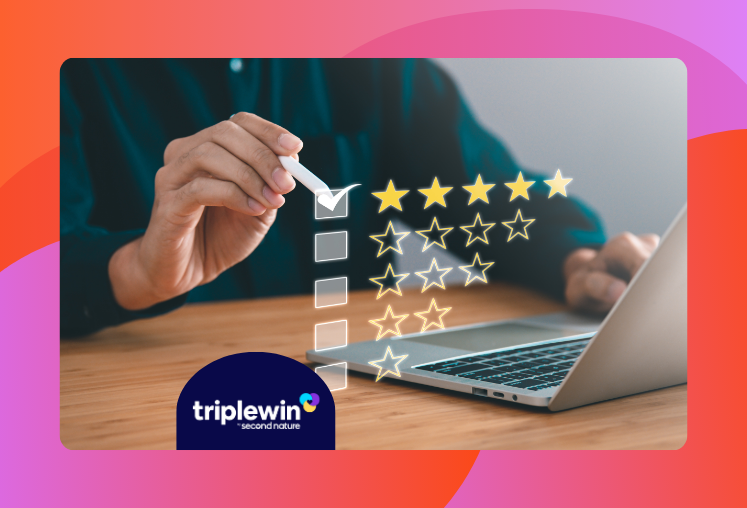We’ve long talked about the importance of the service economy, but recently we’ve seen more and more companies embracing the next evolution of business: the experience economy. Success is no longer about giving your customers quality service, but about providing them a memorable, top-tier experience. For property managers, that means embracing the resident experience as a comprehensive approach to managing.
By providing a great resident experience, you not only set yourself apart from your competitors, but you also increase resident retention and business growth. In this article, we’ll walk through what resident experience is, how to measure it, and how to improve on resident experience metrics.
What is resident experience?
Resident experience is the way that a renter perceives and feels about their living situation. It goes beyond just the quality of the physical property they rent, and includes how well the property is maintained, the ease of moving in, paying rent and requesting maintenance, and every other touch point they have with their management company.
More and more property management companies are beginning to emphasize the overall rental experience through amenities, digital tools, or add-on services that make life easier for their residents.
Why is resident experience so important?
Resident experience permeates every aspect of a renter’s living situation, so it’s essential to maintaining happy, engaged residents. The importance of resident experience is both cultural and financial, but there are four main areas where it has the biggest impact:
- Attracting new residents: Providing a standout resident experience is a great way to bring qualified new residents in the door quickly. By advertising your resident experience perks in your listings, you’ll stand out from the crowd. Plus, happy residents are more likely to leave positive reviews across sites like Google Business and Yelp, which can be an important factor in attracting applicants when you have vacancies.
- Retaining existing residents: A great resident experience can also help avoid vacancies in the first place, since happier residents are more likely to renew their leases. That means less vacancy time, lower marketing expenses, and more time for your team to focus on value-adding activities.
- Building resident investment: Residents who are enjoying their living experience also become more engaged, and have a larger emotional investment in their home. That can lead to lower delinquency rates, more cooperation when scheduling inspections, and an increased likelihood of reporting small maintenance issues before they escalate into big-ticket items.
- Increasing revenue: All of these factors directly drive improvements in your bottom line. When residents sign faster, stay longer, and pay on time, everyone wins. Beyond that, you can often add revenue via lease-enrolled services that provide a better living experience for your residents.
How to measure resident experience: 7 metrics to track
Resident experience can feel like a difficult thing to wrap your arms around. When it touches every interaction that your company has with a resident, it can seem intimidating to measure objectively. But, as the saying goes, what gets measured gets managed, so it’s essential to set resident experience metrics, measure them regularly, and consistently strive to improve them over time.
1. Resident satisfaction
Resident satisfaction is, at its core, how happy a resident is with their experience renting from you. The most common way to measure this is through resident surveys. There are several common times that property managers try to survey residents, often when they’ve recently had an interaction and it’s top of mind. Here are some common examples:
- Just after move-in
- At move-out
- At lease renewal time
- After a maintenance issue is resolved
- After an inspection
All of these offer great opportunities to get honest feedback about recent interactions with your company.
2. Resolution times
One of the most effective ways to keep residents happy is by resolving any maintenance issues quickly and efficiently. Maintenance is one of the biggest disruptions that most residents face, and there’s an increased expectation that they’ll have access to a 24/7 maintenance line and an online portal or app to report issues.
Most property accounting software tools can report out how long each maintenance request takes, from first report to resolution. Keep tabs on these numbers and look for ways to optimize your maintenance and reduce resolution times.
3. Resident community participation
Depending on the nature of your portfolio, the resident community might be an important part of your business. For example, if you manage larger multi-family properties or a large number of scattered-site units in an HOA, neighborhood, or condominium building, you may hold regular community events. Make sure you’re keeping track of attendance at these events and looking for opportunities to increase participation.
4. Amenity usage
Residents who take advantage of amenities are more likely to be engaged with their rental home and renew their lease. You should be measuring how often residents are using things like the pool and the gym, but make sure you’re not forgetting digital amenities, especially if you’re managing single-family homes.
For example, you may be able to run reports to find out how many residents are using services like resident rewards or credit building, which offer great value to residents and can elevate their experience.
5. Digital platform usage
By now, most modern property management companies have invested in digital property management tools, and nearly all of those tools include some kind of resident portal. Whether residents use them to pay rent, request maintenance, or connect with their neighbors, you should be tracking what percent of your residents are using them. Most property management tools will allow you to generate reports showing whether or not residents have activated their portals, and some can also show how often or how recently they’ve logged in. Engagement with digital tools is a great indicator of whether a resident has adapted to your management approach.
6. Renewal rate
Ultimately, renewal rate is one of the most important measures of how happy your residents are. Unhappy residents move out, and happy residents renew (barring other life circumstances). If you’re not already tracking your renewal rate (and your average occupancy length), you absolutely should be. Retention has a massive impact on your business and should be a top priority for improvement.
7. Net promoter score (NPS)
Similar to resident satisfaction, net promoter score, or NPS, measures how likely your residents are to recommend your company to a friend. It’s a common metric among service-based companies, and you’ve almost certainly seen a pop-up asking you to rate your own satisfaction on a one to ten scale. NPS is powerful because it doesn’t just give you an average satisfaction score; it categorizes customers as promoters, neutral, or detractors, giving you a more comprehensive picture of how satisfied they are.
How can property managers enhance resident experience?
Once you’ve put together a process for managing the resident experience, it’s time to focus on improving it. What changes can you make to move the needle and create a better experience for your residents?
Let’s take a look at six different ways you can make life better for your residents, while also creating wins for your company and your investor clients.
1. Update your resident communication
In a people-first business, communication is everything. During move-in and move-out, while scheduling an inspection, or while providing updates on an ongoing maintenance request, you should be providing clear, transparent updates so that your residents feel confident in what’s happening.
Recently, more and more property management companies have adopted texting platforms and instant messaging tools so that they can have real-time conversations with residents without picking up the phone. That’s especially important with younger demographics who may prefer text-based communication. As AI agents get better and better, you might consider adding one to your technology stack in order to provide quick answers to simple questions from residents.
2. Make residents’ moves easier
The move-in experience is one of the most critical moments in the resident lifecycle. Forward-thinking property managers are embracing technology to help, but it’s still not meeting resident expectations. In fact, in AppFolio’s 2025 Renter Preferences Report, they found that 60% of residents said that digital move-in services were important, but only 38% said that they had a digital tool available to them.
Using a dedicated tool to help residents understand their lease obligations, connect with utility companies, and get situated in their new home can add a new level of experience and start off your relationship with residents on the right foot.
3. Provide residents with modern tech conveniences
As digital native generations continue to flood the rental market, offering technology in your rentals is increasingly important. These high-tech amenities can set you apart and make life that extra bit more convenient for your residents. Here are some examples of technology that can move the needle:
- Smart home technology: From connected thermostats to bluetooth lights, there are plenty of low-cost, high-impact items you can add to your properties to add a level of convenience. Even small improvements like adding USB-C ports to power outlets in key locations can make residents feel like your properties are a step above.
- Advanced safety features: Residents are also increasingly expecting access to things like smart locks and internet-connected cameras. They provide peace of mind and a sense of security that residents will appreciate, and have the side benefit of making resolution easier if something does go wrong.
- Visitor management systems: Visitor management systems allow residents to grant access to guests without having to physically let them in. While these are more common in multi-family buildings, they’re useful for single-family homes, too. Smart locks with digital keys can let residents coordinate with guests, dog walkers, and housecleaners much more easily.
4. Provide residents with facilities and amenities they care about
Modern amenities are increasingly popular, especially among younger residents. While multi-family managers may be envisioning huge capex items like pools and clubhouses, it doesn’t have to be so pricey. Instead, consider items like Group Rate Internet, which delivers a service that residents are already paying for, at a cheaper rate. These kinds of conveniences exceed resident expectations while delivering the benefits that they actually want.
5. Upgrade your property maintenance management
We’ve already illustrated why maintenance is one of the most important areas of focus for most property managers. The reality is, a well-maintained, clean, safe property drives a positive resident experience in a way that poorly maintained homes simply can’t.
Make sure to look closely at your maintenance processes to see where you can save time and improve satisfaction. There are several emerging AI tools that help predict and address maintenance issues. You can also drive a decrease in work orders with automated air filter delivery, which keeps HVAC systems healthier and decreases the need for maintenance.
6. Offer your residents additional benefits
If you’re not currently offering a Resident Benefits Package, it might be time to consider it. By offering value-adding services to your residents, you can improve their experience and drive higher satisfaction. For example, you might consider adding:
- Credit building: By reporting on-time rent payments to credit bureaus, you can help boost your residents’ credit scores. In fact, according to the DC Housing Authority, residents who use credit reporting services see an average credit score increase of 29 points.
- Pest control: With on-demand pest control services, you can decrease the amount of time your team spends responding to pest calls, while also delivering faster, better service to residents.
- Resident rewards program: Resident rewards provides discounts, gift cards, and more to residents who pay on time. It’s a great way to elevate their experience with minimal financial investment.
- Renters insurance program: By integrating renters insurance compliance into your lease, you can ensure complete coverage for residents.
Grow your PM business by improving resident experience
In order to thrive as a modern property management company, you need to be laser-focused on delivering a quality resident experience. The best way to do that is by establishing clear measurements, then making business decisions designed to improve those metrics.
If you’re looking for a simple way to improve resident experience without adding more work for your team, check out Second Nature’s Resident Benefits Package. Register now for our next RBP workshop to hear from real property managers about the impact the RBP has had on their business.
Topics:





